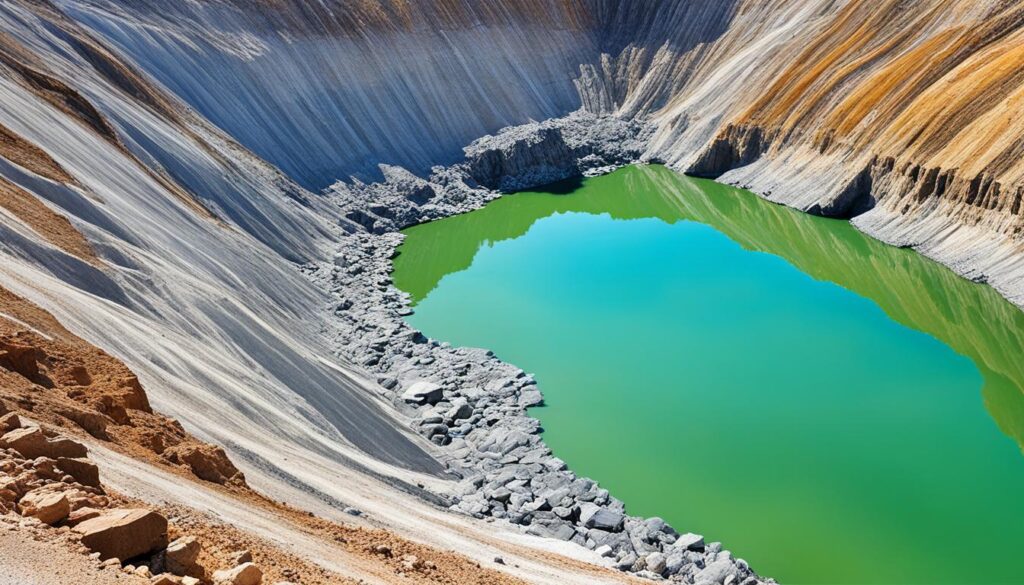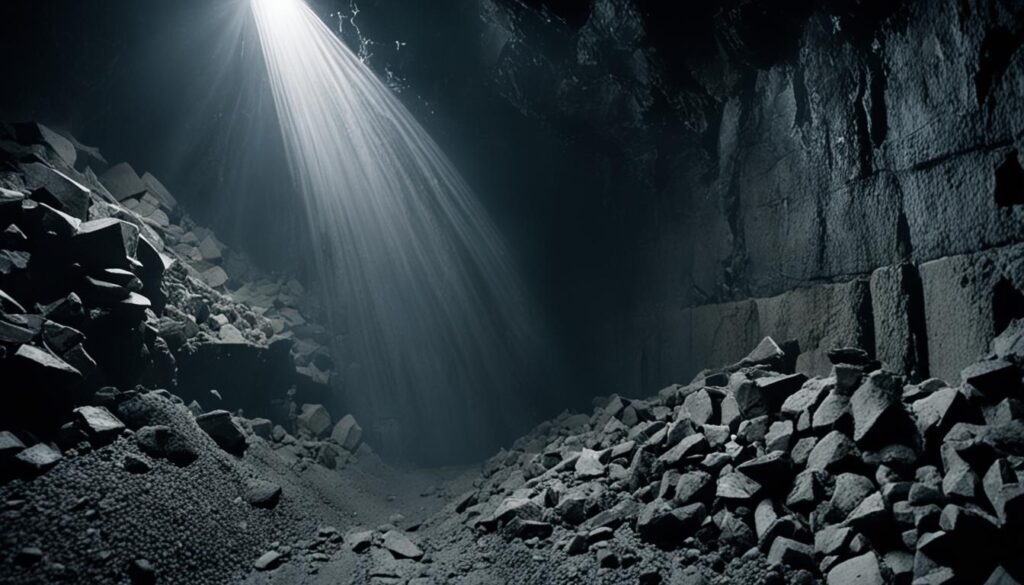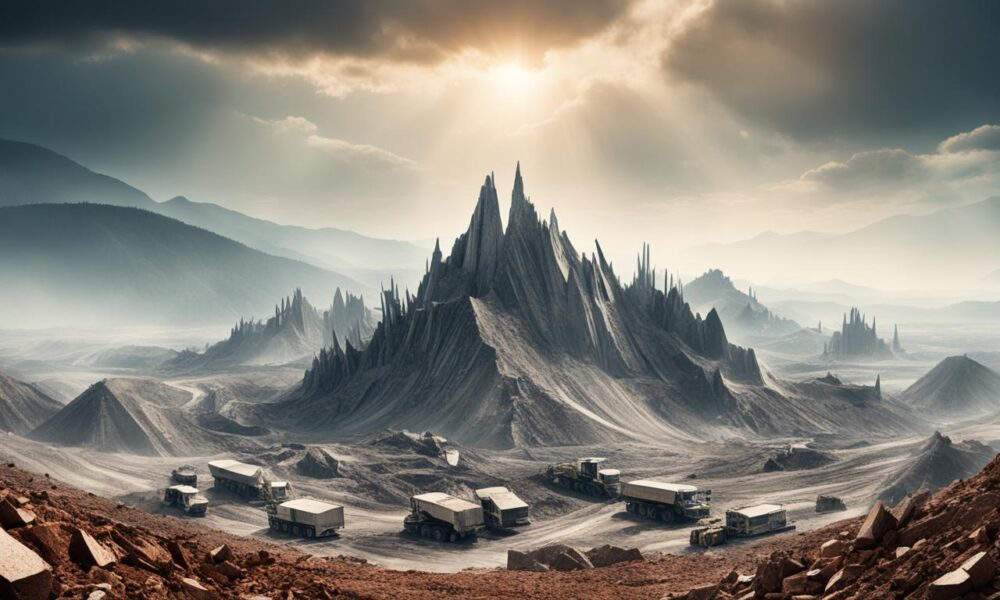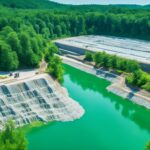Natural Stone Mining: Unveiling Environmental Effects
Natural stone mining adds beauty to design projects but at a high cost. These operations can destroy natural homes for wildlife, reducing biodiversity1. They also lead to cutting down countless trees, clearing huge areas of land1. Plus, they pollute the water, harming fish and possibly even people due to toxins1.
We must think about how to make natural stone mining more eco-friendly. By knowing the bad effects on the environment, we can choose wisely. Using man-made or recycled materials is one way to decrease harm and protect nature. We also can’t ignore the poor working conditions and child labor that often come with mining1.
Key Takeaways
- Natural stone mining has significant environmental and social impacts.
- Mining operations can destroy natural habitats and lead to biodiversity loss1.
- Quarrying contributes to deforestation by clearing vast land areas1.
- Water pollution from mining affects aquatic ecosystems and human health1.
- Labor rights violations are prevalent in the mining industry1.
- Sustainable mining practices are crucial for minimizing ecological footprints and enhancing environmental conservation.
Habitat Destruction and Biodiversity Loss
The search for natural stones changes the land. This includes deforestation and soil erosion. Such activities harm our environment and the health of ecosystems. Mining areas means we lose important carbon sinks. This affects soil stability and biodiversity.
When trees are cut and land is cleared, it adds to climate change. It leads to problems like sediment in our water, hurting nature even more. We need to save our biodiversity. The damage from mining shows we must find better ways to get resources.
Deforestation
Deforestation for getting stones destroys natural homes, causing a big loss of biodiversity. The cutting of plants that help our climate worsens environmental problems2. Also, destroying forests threatens many animals with extinction. Mines in tropical forests can harm more than 1,000 species per square kilometer3.
This leaves fewer animals in those places. It leads to a big upset in nature’s balance.
Soil Erosion
Soil erosion is a huge issue from mining. It costs us about US$65 billion a year because it damages land3. Mining tears up big areas, leaving soil weak against wind and rain. This makes the soil poor and harms plants and animals. Nearby water suffers too, as dirt piles up, causing more harm to homes for wildlife.
In the end, the ecological impact of cutting down forests and soil erosion from mining is very bad. We need to start mining in ways that don’t ruin habitats. Protecting our biodiversity is key to keeping nature in balance.
Water Pollution and Scarcity
Mining for materials like marble and copper can pollute water and reduce its availability. This affects water bodies by adding heavy metals and chemicals. It’s very important to keep our environment safe to solve these issues.
Contamination of Water Sources
Mining for natural stones puts our water at risk by adding harmful substances. Activities in the Canadian mineral industry create a lot of waste daily4. This waste can leak into water, harming both people and animals. Using dangerous chemicals in mines adds to the problem, threatening life in rivers and lakes.

Depletion of Local Water Resources
Mining also uses up a lot of water, making shortages worse. For example, mines in Nevada took a huge amount of water over 15 years4. This usage could have supplied a big city like New York City for a year. It shows how mining can put too much pressure on our water supply.
To reduce harm, mines need to follow better practices. By managing waste, cleaning water before releasing it, and using new tech, mining can be less damaging. These steps will help keep water clean and available for the future.
Labor Rights and Social Issues
Labor rights issues in natural stone mining impact both workers and communities. It’s essential to tackle these problems for ethical industry practices.
Unsafe Working Conditions
Many workers in the natural stone mining field face unsafe conditions. China, a leading stone product exporter, has workers risking their lives daily without proper safety5. Artisanal mining, which makes up most colored stone mining, increases these dangers6. Workers deal with the threat of harm from toxic substances and injuries.

Social and Economic Displacement
Mining activities disrupt economies and social structures. This is evident in China’s Fujian and Shandong, where mining shifts local economies5. Such disruptions cause social and economic hardship. Environmental damage from mining forces communities to move, harming agriculture and stability7. Mining in protected areas like Natura 2000 zones adds to these challenges7.
Health Risks
About 30 million artisanal miners, including children, face health dangers. Their work environments expose them to pollutants and lack safety, leading to diseases6. In areas like Fujian, tackling these health risks is a priority5.
Improving labor rights, ensuring safety, and addressing health dangers are crucial. We also need to lessen the social and economic harm mining brings to communities.
The Environmental Impact of Natural Stone Mining
Mining for natural stone affects the environment in several ways. It can change landscapes and harm local wildlife homes. Open-pit mining, a common method, is especially harmful8. These activities require lots of water, which may pollute our water if not carefully handled9. Transporting stone uses much fuel, increasing air pollution and carbon dioxide levels9.
Natural stone like sandstone is good for the planet because it keeps heat well and doesn’t need much processing8. Yet, it’s crucial for the industry to follow eco-friendly practices. Some are recycling water and using green energy, lessening their environmental harm9. Getting eco-friendly certifications helps improve the air quality inside buildings9.
Reusing stone saves energy, water, and also money8. It’s as good as using new materials but doesn’t waste resources10. Buying local stone supports community businesses, creates jobs, and cuts down on pollution from transport10. Stone structures last a long time, which means less waste from having to replace them often9. These steps help the planet and support sustainable growth in natural stone use.
Stone suppliers now share details about their products’ environmental impact to support green building10. Using safe stone materials helps wildlife thrive and makes our ecosystems richer and more varied10. Together, we can make stone mining less harmful and support a healthier planet.
| Environmental Impact | Action Taken | Potential Benefit |
|---|---|---|
| High water usage and pollution | Water recycling systems | Reduced water consumption |
| High carbon emissions | Renewable energy sources | Lower carbon footprint |
| Habitat destruction and biodiversity loss | Sourcing sustainable materials | Enhanced biodiversity and ecosystem balance |
Conclusion
Marble mining affects our environment a lot, especially the air and water around us. Machines used in mining release harmful gases like carbon dioxide and sulfur dioxide. This contributes to air pollution11. Also, mining can pollute our groundwater and harm local water sources. This shows how urgent it is to find better ways to mine11.
We need to understand these issues to move towards more sustainable practices. By introducing eco-friendly methods, such as cutting down on waste and fixing the land after mining, we can lessen these damages. Mining marble leads to deforestation and soil erosion too. This harms our air, destroys animal homes, and decreases biodiversity11.
Emphasizing green options and sustainable methods in the mining world is key for environmental progress. Companies like Stone Sign Co. show how it’s possible by choosing UK materials, utilizing renewable energy, and recycling. It’s very important to spread the word about these measures and teach people about eco-friendly mining. This way, we can reduce the negative impacts on our air and water quality11.
Learning about marble mining’s environmental impact inspires us to make better choices for our planet. Choosing green alternatives is crucial for protecting our ecosystems and communities worldwide.
FAQ
What is the environmental impact of natural stone mining?
How does natural stone mining contribute to deforestation?
What are the consequences of soil erosion due to natural stone mining?
How does mining affect water quality and availability?
What are the main pollutants from mining activities that affect water sources?
What labor issues are prevalent in the natural stone mining sector?
How does natural stone mining cause social and economic displacement?
What health risks do mine workers face?
Why is it important to focus on the ecological footprint of natural stone mining?
What alternative materials can be used to reduce the environmental impact of natural stone mining?
How can we make natural stone mining more sustainable?
What role do companies like Stone Sign Co. play in reducing environmental impact?
Source Links
- Colorstone® Industries | Blog Details
- What Are the Environmental Impacts of Mining White Granite? – PANMIN
- 7 Negative Environmental Impacts Of The Gem Mining Industry – BIRON® Gems
- Mining and Water Pollution — Safe Drinking Water Foundation
- Social conditions in the natural stone sector in China
- The Color of Responsibility: Ethical Issues and Solutions in Colored Gemstones | Gems & Gemology
- Social and environmental impacts of mining activities in the EU
- The Environmental Impact of Natural Stone Quarrying and How to Source Sustainable Options
- Anderson Granite & Marble Shop of Greenwood – Latest News: 06/14/2024
- The Impact of Natural Stone Building Materials On Sustainability and the Environment – Polycor Inc.
- Mining of Marble and Its Environmental Impact – Indian Natural Stone Exporter,Manufacturer,Supplier & Factory



